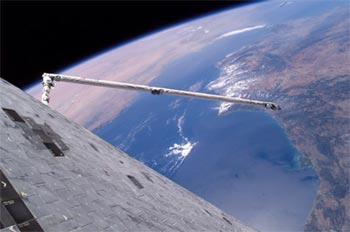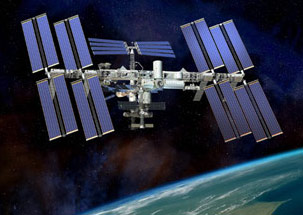On Saturday, May 31, 2008, the space shuttle Discovery is scheduled for lift-off from the Kennedy Space Center in Florida, and when it does its successful re-entry will rely on its capability to capture images of the shuttle’s exterior condition.
Shuttles are equipped with heat shields, which serve as a safeguard during re-entry into the Earth’s atmosphere. Made from ceramic heat-resistant tiles, these thermo-coated heat shields fend off nearly 3000 degrees Farenheit of heat that is generated from penetrating the Earth’s atmosphere.
The success of a shuttle’s re-entry depends on functional heat shields, which must be monitored while in orbit to ensure that no damage was incurred during lift-off. 
The Orbiter Boom Sensor System is located on the 50-foot robotic arm. (Photos courtesy of NASA)
Each member of the NASA fleet of space shuttles now house an Orbiter Boom Sensor System (OBSS), which is an in-flight imaging system attached to the end of a 50-foot robotic arm that is used by the astronauts to scan the underside of the orbiter for possible damage. The OBSS has Kodak CCD Image Sensors that provide up to 30 images per second for high-definition image capture.
The OBSS incorporates a camera (designed by Adimec) that is based on the Kodak CCD imager, which is used to inspect the leading edges of wings, nose cap and crew compartments after each lift-off and before each landing.

The International Space Station (ISS) in orbit.
These images are typically captured during lift-off or during the rendezvous pitch maneuver - when the space shuttle orbits the International Space Station (ISS) as it prepares to dock. The shuttle actually inverts and exposes its heat shield to the crew of the ISS for its photo-op. The information from the image determines whether or not the orbiter is safe for re-entry.
The image sensors actually have several applications during shuttle missions. Since 1995 they have been used to power the astronauts’ handheld digital cameras that capture images from space. In fact, these cameras have captured over 130,000 space images to date that have served to increase public knowledge and awareness of NASA's missions.

The space shuttle Columbia disintigrates on February 1, 2003.
While the use of high-resolution imaging on shuttle missions has proven educational, future use of the external imaging sensors could save lives.
The space shuttle Columbia, which disintegrated and rained debris over the Texas and Louisiana countryside in 2003, had a fatal flaw on its exterior that occurred during lift-off when debris from the external fuel tank peeled off and punctured the edge of the wing. This defect went undetected throughout the 16 day mission and it was later discovered, upon re-entry, that the compromised exterior was to blame for the tragedy.